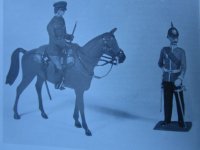Can anyone identify a Britains' horse artillery team of six horses with three riders plus mounted officer and trumpeter? They seem unusual because all the men and horses are in different naturalistic poses, unlike most Britains’ sets.
They have been modified to form a model gun team which will have removed any value that they may have had as toy soldiers. The photo shows their current state where they have been repainted from the original gloss, and changes have been made to tack and equipment, most significantly the original breast harness has been replaced with full horse collars. So the details in the photo are not helpful but hopefully the poses might be sufficiently distinctive for someone to recognise them.
‘Britains Ltd’ markings are on the belly of each horse (as well as ‘Proprietary Copyright’ and ‘Made in England’ on some) which mean they are 1907 or later. I understand that the original breast harness means that they are ‘later’ (because early sets had full horse collars) but the rectangular bases indicate that they are not that late. In some areas the metal is not good quality which may suggest post war, perhaps late 1940s, when there were still shortages.
Any information would be appreciated. Thank you.
They have been modified to form a model gun team which will have removed any value that they may have had as toy soldiers. The photo shows their current state where they have been repainted from the original gloss, and changes have been made to tack and equipment, most significantly the original breast harness has been replaced with full horse collars. So the details in the photo are not helpful but hopefully the poses might be sufficiently distinctive for someone to recognise them.
‘Britains Ltd’ markings are on the belly of each horse (as well as ‘Proprietary Copyright’ and ‘Made in England’ on some) which mean they are 1907 or later. I understand that the original breast harness means that they are ‘later’ (because early sets had full horse collars) but the rectangular bases indicate that they are not that late. In some areas the metal is not good quality which may suggest post war, perhaps late 1940s, when there were still shortages.
Any information would be appreciated. Thank you.



